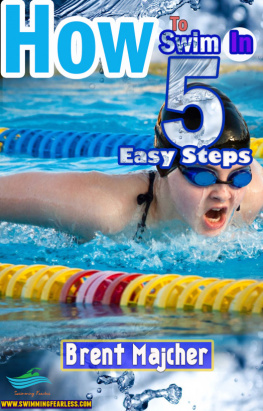This is for Alice, the most generous and caring person I know and my precious partner in life. She makes it all possible.
Acknowledgments
Joe Friel and Lew Kidder shared priceless insights into the sport of triathlon.
All my Total Immersion coaching colleagues helped build "buzz" for TI among triathletes.
Bill Russell allowed us to use the Moriello Pool in New Paltz for photos used herein.
Thanks to Barbara Tomchin, Kermit Hummel and Rob Lias for demonstrating drills and open water techniques.
Thanks to TI coaches, Danielle Sepulveda and Theresa Tolbert on page 72, and Keith Woodburn on page 91 for buddy system and ZipperSkate demonstrations.
Thanks to Joshua Gold, Carol Charbono and Bob Wiskera for demonstrating the exercises in Chapter 19.
Barbara Tomchin, Tara Laughlin and John Delves turned my words into a book. Thanks to all.
And, as ever, thanks to Fiona, Cari and Betsy for humoring and occasionally sharing my lifelong swimming immersion.
Introduction
Why You Are About to Become a Transformed Swimmer!
In 1989, I began teaching adult swimmers at Total Immersion summer camps and was soon teaching a few hundred improvement-minded swimmers each year. Early on, few were triathletes; we were teaching all four strokes and triathletes were mainly interested in freestyle. In 19911 began writing for Triathlon Today magazine (now called Inside Triathlon) and began to see so many triathletes at my swim camps that, in 1993, we began offering freestyle-only programs. Triathletes flocked to these workshops and I recognized their powerful hunger for instruction in swimming technique.
In 1995 I published a book called Total Immersion: The Revolutionary Way to Swim Better, Faster, and Easier, which quickly became the best-selling book on swimming. Though I didn't write this book specifically for triathletes, thousands of multi-sporters made it their swimming bible and the number of triathletes attending TI workshops exploded.
Teaching thousands of triathletes has convinced me that swimming for triathlon (and swimming in open water) is a significantly different sport than competitive swimming (as in age-group, high-school, college, and Masters meets). While most triathletes copy the training programs of competitive swimmers, they shouldn't. Here's why:
Competitive swimming is done mostly in pools; triathlon swimming is done mainly in open water.
Competitive swimmers have spent years gaining specialized skill and experience; more than 90 percent of triathlon swimmers are relatively unskilled and inexperienced in swimming, but still need to swim well now.
Competitive swimming events are primarily 200 meters or less; triathlon swimming happens mainly at distances greater than 400 meters, often much greater.
Competitive swimmers need to swim with intensity; triathlon swimmers need to swim effortlessly.
Competitive swimmers can be specialists; triathlon swimmers have to train seriously in two other sports.
Triathlon swimming truly is a unique sport with unique challenges. This book focuses precisely on how to meet them, whether you are a first-timer seeking the confidence to tackle a long swim in open water, or an experienced competitor wanting to turn swimming into the best part of your triathlon.
The good news is that success at swimming for triathlon is far less dependent on "swimming talent" than you might imagine, and is actually within reach of every athlete. By mastering a finite set of easily learned skills, any smart and diligent athlete can swim dramatically better. I will guide you through that process in the pages to follow. By following this special Total Immersion triathlon swimming program, you'll learn to coach yourself so effectively that, within a short time, you will:
Stand on shore at the beginning of any race and KNOW you can make the swim distance and make it with ease.
Know that you don't have to train as long or as hard in the pool as you thought.
Know you really CAN master this sport that makes so many otherwise successful athletes feel unfit and uncoordinated.
Happy laps,
Tern' Laughlin
New Paltz NY
Terry,
I just got your book, Swimming Made Easy, read it in one sitting and got so excited I dashed off to the pool. I have never spent better time in the water. The first couple of drills felt really awkward at first; I couldn't breath without using my arms to stabilize. Then the balance started to come. So I just merrily floated backwards and forwards for over an hour. For the first time in my life, I had a pretty good idea of how the body should feel in the water. At the end I just couldn't wait to start doing a bit of freestyle and was blown away. So this is what swimming is supposed to be like. Before my balance practice, I'd done 25 meters in 23 strokes and 35 seconds. Afterwards, I did it in 15 strokes and 28 seconds with much less effort. I couldn't believe it, I was just gliding and my arm movements felt as though they were almost incidental to what was going on. After one session I can imagine how much energy I'll have for the bike and run. YEAH!
Every triathlete should experience what 77 swimming is like!! Kind Regards
Craig AbrahamsonSunshine Coast Australia
The lesson: As with any learning process, you'll have ups and downs, experience moments when you wonder if you're doing the right thing, if you really have the ability to improve your swimming. But the value of swimming in an examined way is that your body is a marvelous learning machine and it WILL learn new skills whenever you focus on swimming as a learning experience, instead of as a training regimen. So just get started and trust the value of immersing yourself in a learning experience.

Part 1
Why Swimming Frustrates You and How You Can Achieve Fulfillment
Our first three chapters will give you a succinct explanation of
Why you're not swimming as well as you'd like
Why no amount of fitness, strength, or training will make any real difference
Why swimming easier will improve your total tri-race time far more than swimming faster


















